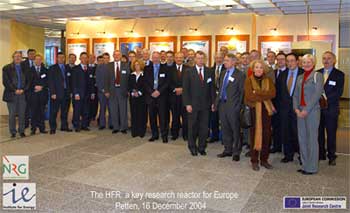
European
Nuclear Society
e-news
Issue 7 Winter 2005
http://www.euronuclear.org/library/public/enews/ebulletinwinter2005/petten.htm

In the context of the Dutch Presidency of the European Union, a timely seminar was held on 16th December 2004 at the Institute for Energy (IE) of the Joint Research Centre (JRC) of the European Commission at Petten, the Netherlands, with the title: “The HFR: a key research reactor for Europe”. The HFR is the High Flux Reactor, located at the JRC site at Petten. The HFR is one of the most powerful, multi-purpose, research reactors in its field, which, amongst others, currently produces over 50% of the European production of radioisotopes, an irreplaceable product in the field of nuclear medicine.

Participants at the HFR Seminar
The seminar was organised for members of the European Commission’s Joint Working Party on Research and Atomic Questions and members of the Atomic Questions Group, as well as a number of representatives from the Dutch Ministry of Economic Affairs and the Ministry of the Environment, each of which has responsibilities towards the HFR, with respect to licensing and regulatory affairs.
A number of speakers, specialists in their area of expertise, were invited to present important topics on nuclear research, with a view to emphasising the importance of the HFR for the European research and radioisotope production needs of the future.
The acting Director General and Deputy Director General of the JRC, Roland Schenkel, welcomed the audience. A brief introduction to the HFR, its organisation and the close cooperation between IE and NRG (Nuclear Research and consultancy Group), both the hosting Petten organisations, was given by Kari Törrönen (Director IE) and Rob Stol (Director NRG). JRC is the owner and currently, licence holder of the HFR, with NRG as the operator, but who will shortly themselves take over the
|
licence from JRC. The reactor is funded by the so-called, Supplementary Programme with contributions there to from the Dutch and French authorities, from Shared Cost Actions, which are partly funded by the Commission’s Framework Programmes, and from Third Party contracts. Irradiation experiments in the reactor cover materials and fuel irradiation testing (HTR, generation IV, fusion, transmutation studies), medical irradiations (BNCT, radioisotope production) and nuclear techniques (SANS, neutron diffraction). The HFR has currently a technical life-time limit to 2020. Hence, its future role in the nuclear community, as well as its future funding, all need to be addressed accordingly. Beyond 2020, plans to construct a new reactor are also a topic under consideration. |
The seminar continued with presentations by six specialists in the following fields:
Reactor Safety Studies and Life Management (Jean-Pierre Hutin, EdF, France)
Transmutation – A Possibility to Burn High-Level Nuclear Waste (Joachim Knebel, Forschungszentrum Karlsruhe, Germany)
Materials Research for Future Thermonuclear Fusion Reactors (Eberhard Diegele, EFDA, Germany)
Medical radio-isotopes (Henri Bonnet, IRE, Belgium)
Advanced Medical Radiotherapy (Wolfgang Sauerwein, Duisburg-Essen University, Germany)
Training and Knowledge Management in the Nuclear Field (Frans Moons, SCK/CEN, Belgium)

Outside view of the HFR Petten at night
During the afternoon, a tour took place on-site to the HFR, including the BNCT facility, and to the Molybdenum Plant (Tyco). Thereafter, participants re-assembled back in the conference room for a session of Q&A. Firstly, Marc Becquet (JRC, Brussels) gave a brief presentation of the intended Joint Undertaking (JU), which will replace the HFR Supplementary Programme. The JU will be in the form of a member’s club or association of entities, composed of the principal users of the HFR. In the first instance, JRC, NRG and also some of the current customers of the HFR will join. Partners may join and resign anytime, whilst the method of payment could be via financial contracts or work-in-kind. The JU is still only a proposal, but is one the highest priorities to be addressed in the next 12 months.
(Courtesy of the Joint Research Centre)
![]()
© European Nuclear Society, 2005